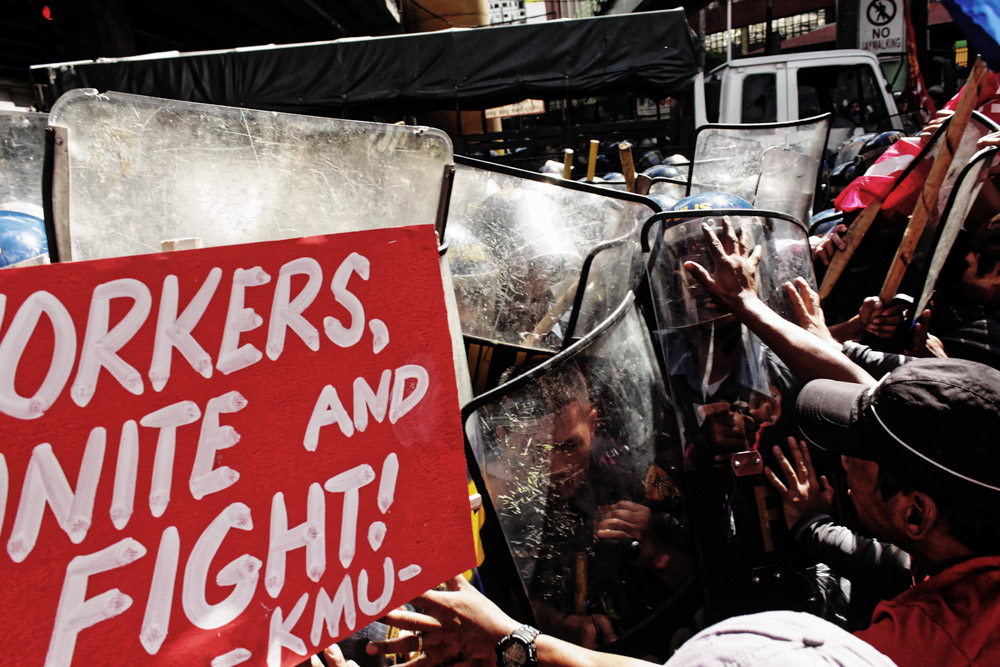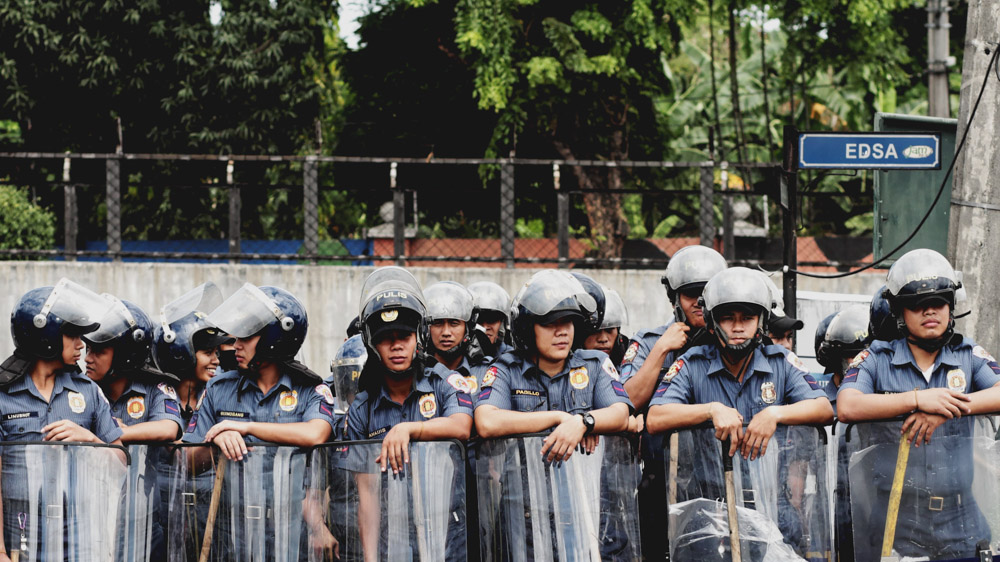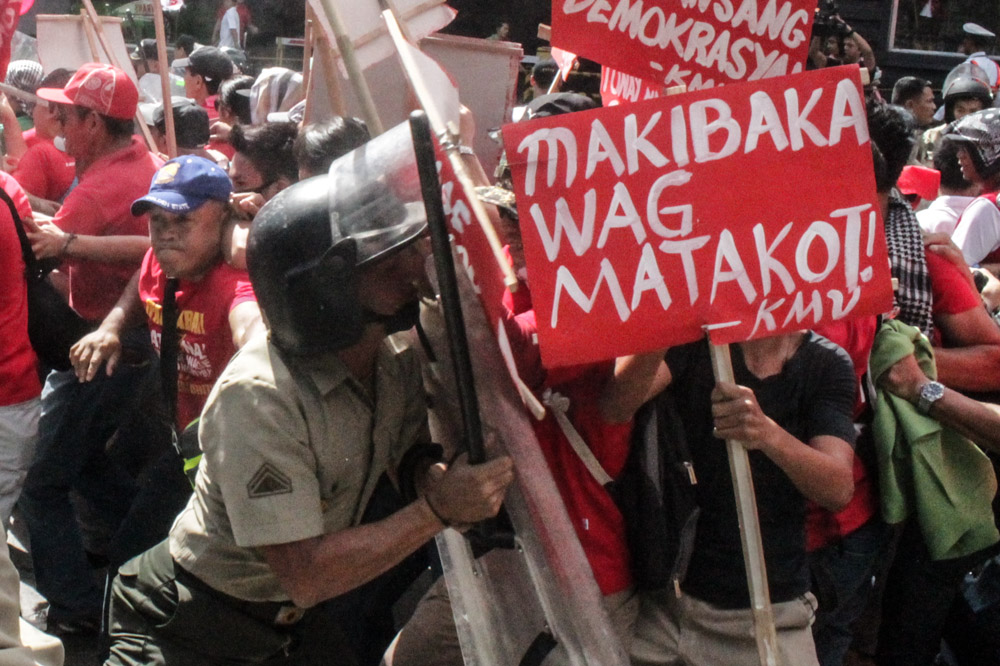The morning of February 25 reminded us of a revolution that toppled a dictator 30 years ago.
Under the afternoon heat along Ortigas Avenue, flags with the predominant color of red were waved in the air. For the hundreds who marched along EDSA, the People Power Uprising of 1986 was not so much a revolution as it was a mere change in the names of the ruling few.
Hundreds of Philippine National Police (PNP) personnel blocked the streets to prevent protesters from approaching EDSA Shrine. The protesters clashed with the police as the former marched towards EDSA Shrine, a scene reminiscent of the historic triumph of the people in EDSA.
Meanwhile, the state-sponsored commemoration was as pomp and polished as the early People Power was not.
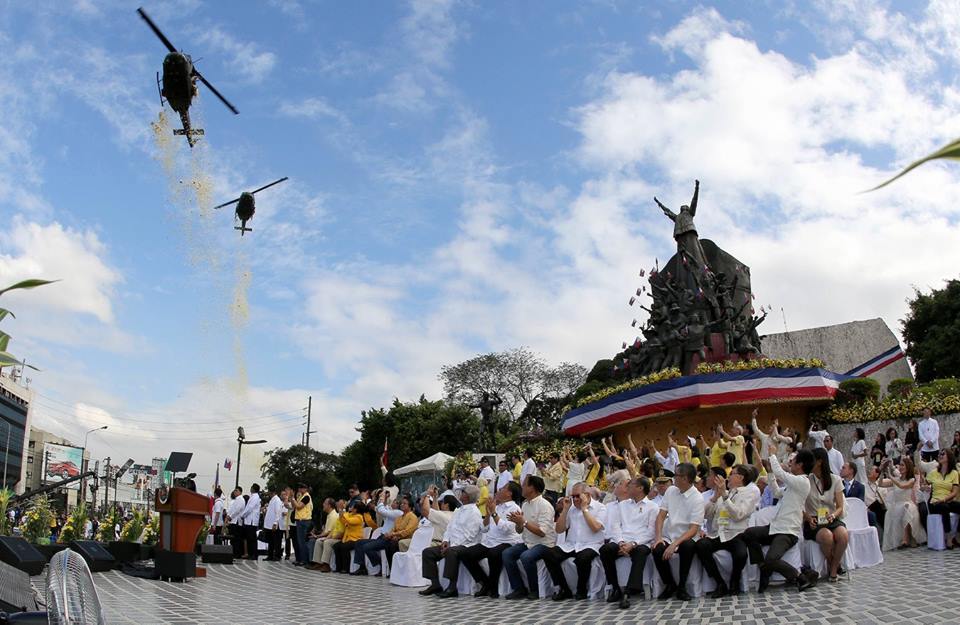
Earlier in the day, yellow confetti littered Ortigas’ main roads and flyovers. White, blue, and yellow flags adorned EDSA Shrine. During the commemoration program of the People Power Uprising’s 30th anniversary, President Benigno “Noynoy” Aquino III reminded the Filipino people of his parents, Benigno Aquino, Jr. and Corazon Aquino, considered by many to be heroes of our country’s restored democracy.
While Bagong Alyansang Makabayan (BAYAN) believes that the People Power Uprising in EDSA proved that collective action could overthrow a ruling regime as the Marcos dictatorship, the group insists that fundamental change is yet to be seen.
Land reform, a barren promise
According to Kilusang Magbubukid ng Pilipinas, nine out of ten farmers do not own land. Genuine land reform still eludes the haciendas and plantations in the countryside.
People Power installed Cory Aquino as the new president bearing land reform as her administration’s flagship program. But there is no genuine land reform to speak of until today.
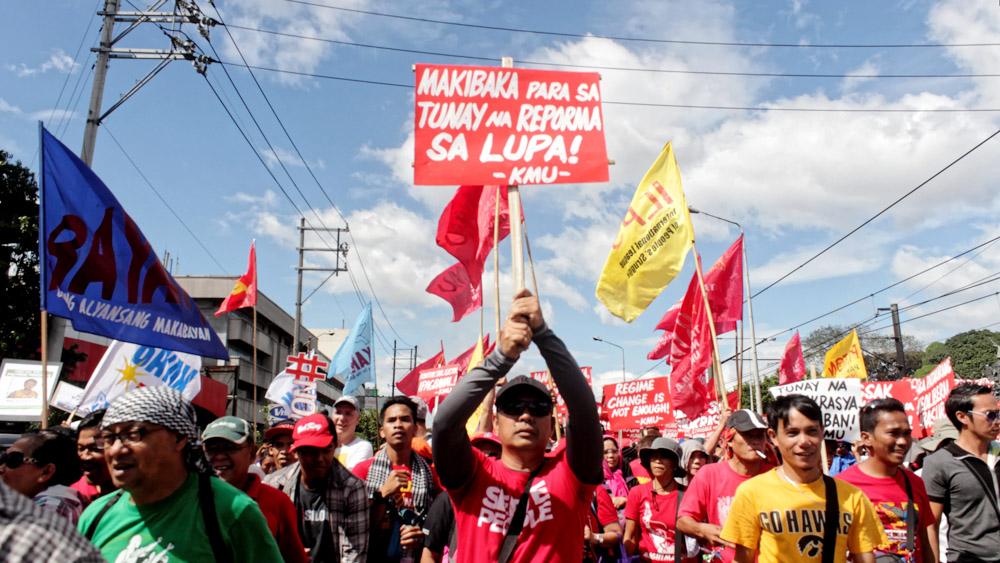
The infamous Mendiola massacre that killed 13 peasants when soldiers opened fire at protesting farmers at the gates of Malacañang Palace happened on January 22, 1987, less than a year after EDSA People Power and only a few months after Cory rose to power.
“Cory’s Comprehensive Agrarian Reform Program (CARP) did not break down the monopoly of landlords. How could it when Cory’s family are among the biggest landlords in the country?,” said Raymond Palatino, BAYAN Metro Manila Chairman.
Through CARP, the Cojuangco- Aquinos were able to retain their ownership of the land using the stock-distribution option, making the farmers and farm workers stockowners instead of landowners.
The Hacienda Luisita massacre, instantly took the life of seven farmers on November 16, 2004, when Noynoy Aquino was Congressman of the district. The farmers and farm workers were on strike. Soldiers from the nearby camp and security guards of the hacienda opened fire at the protesters.
The Supreme Court decided with finality in 2012 the awarding of the almost 5,000-hectare Hacienda Luisita to the farmers.
“The Cojuangcos continue to evade land reform in Hacienda Luisita to this day by their tambyolo type of land awarding, selling the prime lots to private corporations or the government of Noynoy Aquino to lessen what could be land and profit divided among the farmers,” added Palatino.
Onslaught of neoliberalization
Workers now slave for low wages and constantly face the threat of termination under instituted contractualization that started in Cory’s time.
The Herrera Law, enacted on March 2, 1989, amended the Labor Code, created the legal grounds for contractual work arrangements that cheapened workers’ wages and also introduced the policy of Assumption of Jurisdiction (AJ).
Under Articles 106-109 of the Herrera Law, the labor secretary is given the power to issue orders that will promote hiring of contractuals and other non-regular workers such as Department Order 18-A issued in 2011. Meanwhile, Article 263 authorizes the labor secretary to issue an Assumption of Jurisdiction (AJ) order that will serve as basis for the swift deployment of police and military forces in companies with labor disputes. The AJ is a government crackdown of strikes that was used also during the Hacienda Luisita massacre.
Workers spent the non-working holiday taking part in the protest.
The selling of state properties and bankrolling private companies instead of strengthening the state’s capacity to manage and provide public utilities such as electricity, water and irrigation also started under Cory’s presidency.
“The government gave away the opportunity to strengthen and build its own industries to favor private corporations. This situation created by the government made it easy for them to turn to the solution of selling government properties, even at the expense of the Filipino people. We now have to source basic utilities from private companies and the government even deregulated many industries central to public interest. We now have to pay rising prices of utilities and goods though service is bad or inadequate,” said Palatino.
Continuing human rights abuses
Among those who protested on the 30th anniversary of People Power were survivors of torture and political repression during Martial Law. According to them, the same brand of repression exists until today.
In different speeches during the three-hour program along EDSA, groups described the violence brought by paramilitary groups and vigilantes that sprang when Cory Aquino was president; the all-out war versus Moro armed groups of the Estrada administration; the extrajudicial killings (EJKs) under the Arroyo regime; and the heightened number of political prisoners, EJKs, and massive displacement of national minorities of the current administration.
One speaker noted that one day before the anniversary of the People Power, the evacuation site of 700 Lumad in UCCP Haran in Davao City was burned by alleged paramilitary and military forces. The Lumads have continuously faced harassment from military and paramilitary groups since they evacuated to the UCCP Haran. The existence of paramilitary groups today was reminiscent of Cory’s low-intensity conflict counterinsurgency program; guised as community service-oriented and when vigilante groups perpetrate systemic state violence.
No more Marcos, People power still relevant
“While the people realizes that there has been no substantial social change under Cory and the succeeding governments up to her son Noynoy, we should also not forget Martial Law,” said Palatino.
Members of the Campaign Against the Return of Marcoses to Malacañang (CARMMA) joined the protest. CARMMA launched a series of gatherings of Martial Law victims and protests against Bongbong Marcos’s candidacy, one of which is a mass in Redemptorist Church in Baclaran accidentally attended by Imelda Marcos. (Read related story here.)
As Bongbong Marcos continue to target youth and millennials who did not experience Martial Law to bolster his campaign, CARMMA members vow to continue to expose the evils of Martial Law and deter his ambition for the second highest seat in the land.
BAYAN Secretary General Renato Reyes, meanwhile, reminded of the importance of People Power as another round of election nears.
“People Power happened because of the clear inability of the elections to resolve the crisis of Philippine society. People Power remains relevant today in the face of oppression and injustice. It remains a valid weapon for changing society,” Reyes said.

